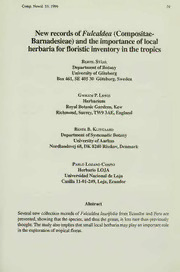
New records of Fulcaldea (Compositae-Barnadesieae) and the importance of local herbaria for floristic inventory in the tropics PDF
Preview New records of Fulcaldea (Compositae-Barnadesieae) and the importance of local herbaria for floristic inventory in the tropics
Comp.Newsl.33, 1999 39 New records oiFulcaldea (Compositae- Bamadesieae) and the importance oflocal herbaria for floristic inventory in the tropics BertilStAhl DepartmentofBotany UniversityofGoteborg Box461,SE40530 Goteborg,Sweden GwiLYMP.Lewis Herbarium RoyalBotanicGardens,Kew Richmond,Surrey,TW93AE,England BenteB. Klitgaard DepartmentofSystematicBotany UniversityofAarhus Nordlandsvej 68,DK8240Risskov,Denmark PabloLozanoCarpio HerbarioLOJA UniversidadNacionaldeLoja Casilla 11-01-249,Loja,Ecuador Abstract Several newcollection records ofFulcaldea laurifolia from Ecuador and Peru are presented, showingthatthespecies, andthusthegenus, islessrarethanpreviously thought.Thestudyalsoimpliesthatsmalllocalherbariamayplayanimportantrole intheexplorationoftropicalfloras. 40 Corap.Newsl.33, 1999 Introduction The genus Fulcaldea Pom. consists of a single, highly characteristic species, F. laurifolia (H. & B.) Pok. ex Less., endemic to the dry zones of western and southernEcuadorandnorthernPeru(Harling 1991,Brako&Zarucchi 1993).The speciesformssmall,evergreentreeswithawelldemarcatedtrunk,amuch-branched crown,andcoriaceous,3-veinedleaves.Thecapitulaaresingle-floweredandarranged in dense synflorescences at the end ofthe branches (Fig. 1). The pappus bristles, whicharelongerthanthecorolla, areplumoseandhaveapalepinkishtinge,giving thesynflorescencesandindeedthewholefloweringtreeapinkishtinge. FulcaldeaisprobablymostcloselyrelatedtoBamadesia,amainlyAndeangenusof some 25 species. It differs from that genus by its single-flowered capimlaand by having thestyle distinctly swollenbelow the lobes (Fig. 2), two feamres uniquein the subfamily Bamadesioideae (Bremer 1994). According to Bremer (1994), Fulcaldea differs also from Bamadesia in having ecaudate anthers (vs. caudate), endothecial tissue with radial thickenings (vs. without thickenings), and in pollen morphology. ForhistreatmentofFulcaldeaforFloraofEcuador,Harling(1991)onlysawthree collections, i.e. thetypecollectedbyHumboldtandBonplandintheLojaProvince in 1802,andtwocollectionsfromthecoastalprovinceofManabimadein 1893and 1955.Becauseofthis,Harlingstatedthat''Fulcaldealaurifoliaisapparentlyarare species". RecentfieldworkhasrevealedthatF.laurifoliaoccursingreatnumbersat certainlocahties,bothintheLojaProvince(pers.obs.)andintheMachalillaReserve (C.Josse,pers. com.)intheprovinceofManabi. Distributionandecology Fulcaldea la—urifolia is distributed (Fig. 3) in the coastal lowlands ofthe Manabi m Provi—nce(50 150 alt.)andintheuplandsofsouthernEcuadorandnorthernPeru m (650 1850 alt.). It grows in dry deciduous forests, but at most localities these forestsarenowdegradedbecauseofloggingandgrazing,thelattermainlybygoats anddonkeys. Despitethedifferenceinaltitudethedisjunctdistributionisnotunexpectedconsidering theclimaticsimilarityofthesetwoareas.Furthermore,therearemanyotherwoody plants occurring in both areas (e.g. Achatocarpuspubescens, Burseragraveolens, Ceiba trischistandra, Cordia lutea), although mostofthesehavemuch largertotal distributions. Comp.Newsl.33, 1999 41 The species flowers fromMarch through September, typically thedriestperiod of theyear. CollectionsofFulcaldea ECUADOR.Manabi:Jama,5kmfromPedemales,50m,80°14'W,00°10'S,Corneig s.n. (GUAY). El Recreo, 80°27'W, 00°29'N, 1897, Eggers 14944 (GB, K). San Vicente, 1935,Asplund 16595 (K, S). MachalillaNationalPark,RioPinas, 80°41' W, 1°39'S, 150m,28Jul 1994,Josse1063(AAU,GB).Loja:3-6kmNofSozoranga onroadtoTumbanuma, southern slope above Suquindastream, 79°47'W, 4°19'S, 1600-1700 m, 18 Sep 1989, Munday & Maldonado 001 (QCNE). 5 km from CatacochaonroadtoSanVicente,79°39'W,4°6'S,2000m,26July 1990,J0rgensen etal.92152(AAU).5kmfromCatacochaonroadtoLomaQuemada,79°36'312"W, 4°6'95"S, 1600m, 16Apr 1996,Lewisetal. 2247 (AAU, K,LOJA,QCA,QCNE). Sozorangaoutskirts, 1 kmalongtracktoUtuana,79°47'W,4°20'S, 1700m, 5 Mar 1997, Lewis & Lozano 3038 (AAU, K, LOJA, QCNE). Km 2 onroad Sozoranga- Yaramine, 1750 m, 79°48'W, 4°18'S, 14 June 1997, Klitgaard, StAhl et al. 203 (AAU,LOJA, K). Sozoranga,km4alongtrackfromSozoranga-Macararoadtothe ElTundoReserve, 1850m,79°49'W,4°19'S, 19Aug 1997,Lewisetal.3497(AAU, K,LOJA, QCA, QCNE). NearSozorangaonroadto Suquinda, 1500m, 79°48'W, 4°22'S,Lozanoetal.299(LOJA).Yamana,79°40'W,3°59'S,Aug 1976,Vivar871 (LOJA).LaVegaGrande,79°32'25"W,4°5'16"S,27May 1982,Vivar1568(LOJA). PERU.Piura:Prov.Ayabaca, 18kmabovePuenteTandopa(RioQuiroz)onroadto Ayabaca, 1700 m, 24 Sep 1964, Hutchison & Wright 6685 (K, NY). Prov. Huancabamba,LaAfiladera,650m, 12Sep 1981,Lopez&Sagastegui8774(NY). Vernacularnamesanduses ThecommonnameforthisspeciesintheLojaprovinceis"guayache"("guallache"), whereasonthecoastitisknownunderthenameof"sobretana".Thewoodisstrong andinsouthernEcuadorthespeciesisusedinhouseconstruction,especiallyasroof support,andasfenceposts. Remarks The present investigation shows that Fulcaldea laurifolia is less rare than was previously thought. In fact, it is locally abundant, both near Sozoranga and in the MachalillaReserve,andisatcertainplacesoneofthemostcommonwoodyspecies. 42 Comp.Newsl.33, 1999 Theresultsalsohavesomeimportantimplicationsfortropical floristicinventoryin general.Firstly,theimportanceoflocalherbariaandlocallybasedcollectionprogram- mescannotbeunderestimated.TheLOJAherbariumhasgrownanddevelopedcon- siderablyduringthelast 10yearsandisnowaveryimportantresourceforbotanical investigationsinsouthernEcuador.Thesamecanbesaidaboutthesmallbutquickly growingherbariuminGuayaquil(GUAY),whichnowhousesimportantcollections fromtheEcuadoriancoast. Secondly, thefloweringperiodofFulcaldea laurifolia, March through September, is no doubt undercollected in general. Most older collectionshavebeenmadebyEuropeanandNorthAmericanbotanistsvisitingthe tropicsinthenorthernhemispherewintertime.Localcollectionprogrammesunbiased by"wintervacations"willcertainlyrevealmanynewrecordsinthefuture. Acknowledgement We thankCarmenJosseforproviding information on Fulcaldea intheMachalilla Reserve. References Brako, L. & J. L. Zarucchi 1993. Catalogue oftheflowering plants and gymnospermsofPeru. MissouriBotanical Garden, St. Louis. Bremer,K. 1994.Asteraceae. Cladisticsandclassification.TimberPress,Portland, Oregon. Harling,G.1991. Compositae-Mutisieae.In:FloraofEcuadorAl.(eds.G.Harling & L.Andersson),BerUngs,Arlov. Comp.Newsl.33, 1999 43 Fig. 1. Fulcaldealaurifolia. A habit, floweringbranch(x 1/6,Lewisetal. 3497); B stemwithspines(x 1/3, Vivar 1568).Del. G.Lewis. 44 Comp.Newsl.33, 1999 Fig.2. Fulcaldealaurifolia. Asingleflower(x2);Blongitudinalsectionofovaryandpappus(x 2.5);Ccorolla (x 3.25); D developing achene and pappus (x 2); E style tip and stigma (x 10); F longitudinal section of achene apex (x 8.5; o = ovary, n = nectary, s = style); Ganther(x7). (Lewisetal. 3497). Del. G.Lewis. Comp.Newsl.33, 1999 45 Ecuador Fig.3.DistributionofFulcaldealaurifolia.
